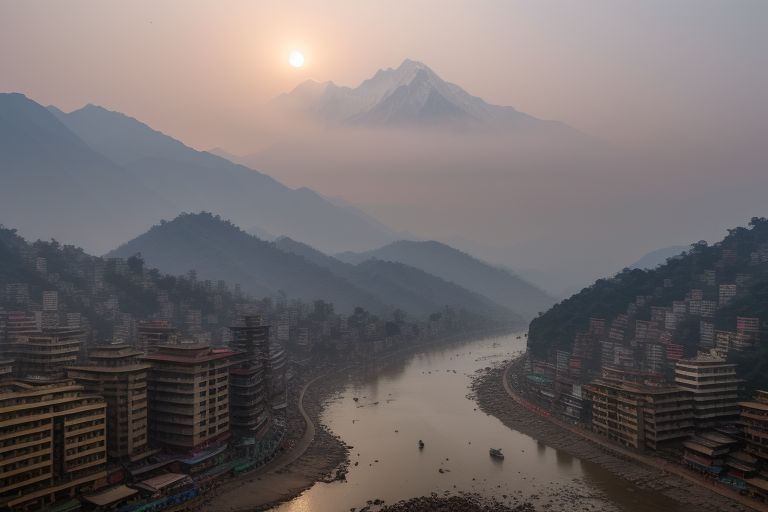Though air pollution has reached alarming levels in many cities of Nepal including Kathmandu, the country is struggling hard to cope with the emerging environmental issue. The government has launched a new number of strategies to fight against this urgent problem, which affects the health of the population and the state’s economy.
According to Department of Environment data, AQI for Kathmandu valley has been above 150 in recent weeks, which falls in ‘unhealthy’ category. The AQI has gone beyond 300 a number of times, this being a sign of “hazardous” air quality. The levels of pollution depicted here are mainly in a result of vehicle exhaust, industries, and fire production from waste and crops.
It has grown so acute that schools in Kathmandu Valley recently had to shut down for several days for the unhealthy environment last week. This decision, endorsed by local authorities in discussions with consultants from the health sector, demonstrates the now effect of pollutants on the observed life and the necessity of action.
The crisis has not gone unnoticed and Nepal’s Ministry of Forests and Environment has come up with the following measures to deal with the air pollution. This way the plan contain both short term remedial actions to meet the immediate need to reduce pollutions as well as long term solution. Some of the main strategies include; enhanced standards of vehicle emission, development of efficient public transportation systems alongside the enhancement of electric vehicles.
Of these, perhaps the most ambitious is the government’s proposed policy to bar vehicles older than 20 years from accessing urban centers. This policy is designed to cure the most polluting vehicles from the roads, but there has been an outcry from the transport unions and owners of old and highly emitting vehicles claiming they are schemes that work towards polluting and impoverishing the poor.
The government has also proposed to increase greenery for the city with proposal to plant one million trees in Kathmandu Valley alone in the next five years. These measures are to assist in the enhancement of improved air quality as well as urban environment and the general quality of people’s lives.
The Ministry of Industry in an effort to control industrial pollution has put new measures whereby all factories are to have installed air pollution control devices in the next six months. Violations to these regulations will attract penalties that include fines and maybe forceful closure of the factories. Although, industry representatives claimed that such measures will raise their costs, environmental organizations received the news as a positive signal promoting cleaner air.
Another area that is coming under intense government pressure in its war against pollution is the agricultural sector. The Ministry of Agriculture has also started a campaign to discourage the farmers to burn the residue from the harvests, saying that the activity deeply contributes to air pollution at some particular periods. It contains educational programs targeting farmers and shares financial rewards for changing 750,000 acres of traditional burning practice.
The educational activities of the government play a significant role and thus focus on public awareness. The National Health Education, Information and Communication Centre has recently launched a large-scale campaign to raise awareness about adverse health effects of air pollution and personal actions towards emissions reduction. This includes the wearing of masks, avoiding the use of private cars and the right disposal of wastes.
Still, some of the environmental activists and health experts have criticised the measures as not very adequate. Dr. Arjun Karki, a pulmonologist, went even further and said, Though these are very welcome, it is about time that we take more rigorous actions to defend public health. This level of pollution damages people’s health in the long run, and some effects are unchangeable.
The timely social cost of pollution of air in Nepal is also gradually coming to the foreground of the economy. An estimate in the World Bank’s report done recently mentioned that air pollution standards cost the country about 3.4% of its GDP on productivity and healthcare costs annually. This economic burden, therefore, puts more pressure on the need to contain pollution.
The United Nations is also involved in helping Nepal to reduce emission of the pollutants that cause air pollution. Currently the Asian Development Bank has expressed willingness in supporting urban air quality improvement projects while on the other hand the World Health Organization is offering technical cooperation in air quality as well as health impact studies.
Thus, while Nepals carries on with this environmental problem, effectiveness of these new steps will be well monitored. It has to be borne in mind that the capacity of the government to apply and enforce such policies effectively will be decisive in deciding the facts as to whether Nepal is going to turn the tide on its worsening air pollution and improve the quality of air in the country. The next several months are going to be important in identifying effects produced by these measures and possibly defining the next actions of the government in tackling this significant national concern.


